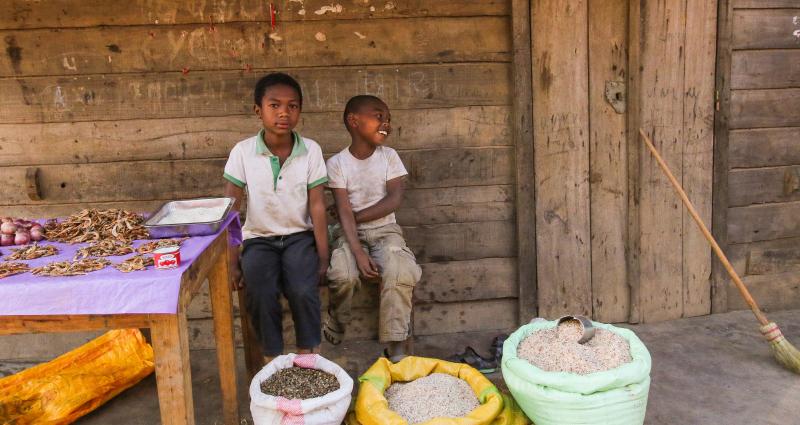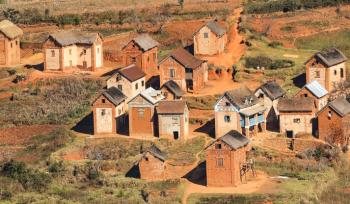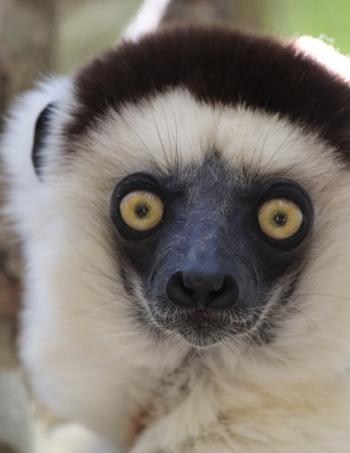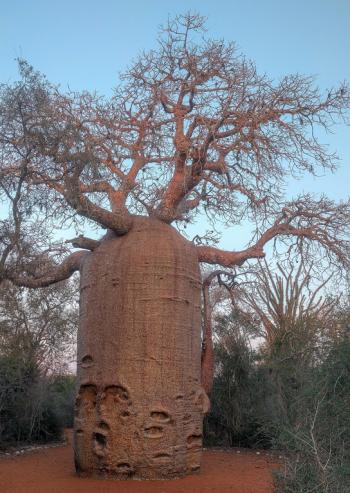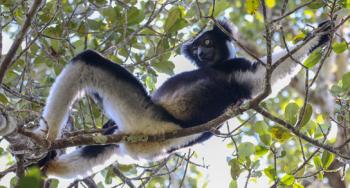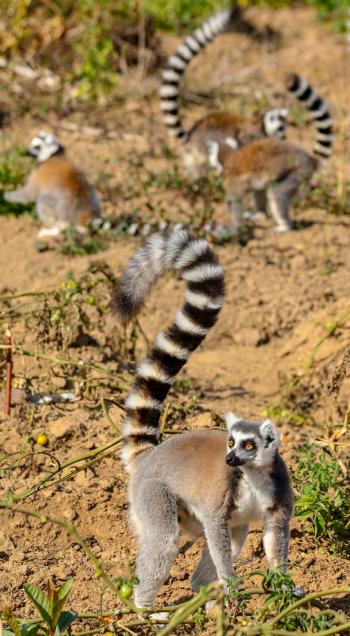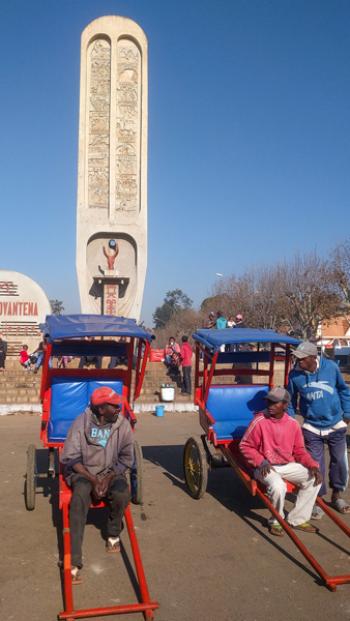Car and driver with Roadtrip Madagascar
This item appears on page 16 of the January 2021 issue.
Madagascar is a “must see” for world travelers and anyone interested in wildlife. My wife, Norma, and I fit both of those descriptions, and we spent two weeks there in August 2018.
I did all of the initial planning and booking of our 2-week trip. Norma and I selected an itinerary along the RN7, a main highway, that would increase our chances of seeing wildlife.
In making inquiries to accommodations, I got answers from some after a week or more, and others never replied. I found that if I used Google to translate my message into French, I could reach most places. (A person responding from one hotel told me my French was “impeccable.”)
We ended up hiring a car and driver from Roadtrip Madagascar (Ivato, Madagascar; www.road tripafrica.com/madagascar), whose office is in Ivato, home to Madagascar’s international airport and near the capital, Antananarivo. We stayed the first night in Ivato at the B&B Susie’s Place.
Roadtrip Madagascar has a very informative website. I used the information in the planning, making many of their suggested stops and contacting some of their suggested hotels. When a hotel did not answer or was booked, I used Lonely Planet and Bradt guides for further booking information.
Hiring a driver turned out to be an excellent idea. Running from the capital, the RN7, finished by the French in 1960, is a narrow 2-lane road with many curves and one-lane bridges, no traffic lights and almost no shoulders but plenty of potholes.
Our driver/guide, Tojo, who spoke English and had once been a birder guide, tweaked our itinerary. We had not planned to travel to the coast or visit the spiny forest. He suggested this part of the trip and a change from a location that was mainly scenic to one that had more of what we were interested in: wildlife and endemic plants.
Tojo had no problem rebooking us in new accommodations for three of the nights. Those cost us $30-$40 a night, which was lower than the typical costs I had been quoted directly while still in the US.
At the start of our journey with Tojo, I found myself cringing as Mercedes trucks came barreling around the bend. Norma would close her eyes. But after 1,500 miles of travel, it took a huge vehicle to make an impression.
Travel there can be slow, averaging about 35 mph in some sections and 50 at most. Drivers honk their horns to let cars know they’re coming through or to alert the many pedestrians, animals and “sleds” (wheeled carts coasting downhill) sharing the road. Trucks in front of you flash their right-turn signals if it’s safe to pass.
The countryside was variable — mountains, plains, valleys, rice terraces and even a section that wouldn’t look out of place in Utah.
We seemed to always be going either uphill or downhill. Vegetation was continually changing.
Part of the RN7 goes through the longest plateau in the country. We passed small villages with houses crowding the road. Many had shops, and whole communities often specialized in particular products: sausage, honey or pineapples. Their wares were on display for all to see.
There were no rest areas. We had to wait for the nearest gas station or restaurant, so there always ended up being a trip to the nearest “bush toilet.”
It was winter there in August, with temperatures varying by altitude. Some nights and early mornings, we could see our breath.
Madagascar has many national parks and reserves as well as preserves run by local communities. Preserves provide training and employment opportunities for the locals, and entrance fees go to the community.
Unaccompanied travel is not allowed in any of the parks or preserves. In addition to paying an entrance fee, you must hire a local guide, who often has a spotter to help. Language can be a problem, but all of our guides were able to communicate with us.
The guides were very knowledgeable, knew where to find the lemurs and birds and were serious about their work. They wanted us to see the animals we’d come so far to find! If you are a birder, you may find yourself bushwhacking until they find the target endemic bird you must see.
Madagascar is long and narrow, and distances are measured in hours rather than miles. Our first stop was Eulophiella Lodge, outside Andasibe. Early the next morning, we headed to Andasibe-Mantadia National Park, where we saw the indri lemur (largest of the lemurs) and also eastern woolly and common brown lemurs.
We traveled a day to reach Antsirabe, where we spent the night. That was followed by two nights at Setam Lodge, across the valley from Ranomafana National Park. During a night walk on a beautifully bright but chilly evening, we saw the Southern Cross, Mars and the Milky Way above us. We also saw a small rufous mouse lemur, along with several kinds of chameleons.
The next day, we took a long trek in Ranomafana National Park to see four species of lemur — golden bamboo, greater bamboo (endangered), red-bellied and the beautiful Milne-Edwards’s sifaka — plus birds.
Following a short drive to Ambalavao, where we visited a zebu (cattle) market, we spent the night at the lodge Espace Zongo in Fiana rantsoa. The nearby Anja Community Reserve was one of the highlights of the trip, as we walked among makis (ring-tailed lemurs).
In Isalo National Park, we took a moderate trek to a plateau for a view of canyon lands. The next day, we walked to the campground, where we saw a large black-and-white Verreaux’s sifaka and hiked along a scenic gorge that ended at a waterfall. Lunch was a barbecue picnic surrounded by ring-tailed lemurs looking for treats.
We then drove an hour from our lodge to Zombitse-Vohibasia National Park for a leisurely walk, seeing many birds.
Mangily was the last stop before our return to Antananarivo (Tana), where we stayed at the Bamboo Club, near the Mozambique Channel. We left before 6 a.m., after a quick breakfast, to go birding at the community-run Reniala Nature Reserve, which protects part of the spiny forest.
The reserve is home to a thousand baobabs in all shapes and sizes, one of which measured over 40 feet around. We also saw euphorbia (flowering perennials), an octopus tree and balsam aloe. Our enthusiastic guides succeeded in getting us great views of 14 endemic birds.
It took three days of driving to get back to our starting point in Ivato. On our last day, we left at 6:30 a.m. to go birding at Parc de Tsarasaotra in Tana. The lake at its center and surrounding trees are like magnets for hundreds of ducks, herons and egrets.
We flew Turkish Airlines round trip, Philadelphia-Toronto-Istanbul-Mauritius, for $1,618 per person. We flew Air Austral round trip, Mauritius-Reunion-Antananarivo, for $526 per person. Our total trip time was five weeks, with stopovers in Mauritius and Réunion and a side trip to Rodrigues island before arriving in Madagascar.
We paid $1,870 to Roadtrip Madagascar for our 2-week car rental, which included a driver/guide. Gas cost a total of $300. Our accommodation costs ranged from $30 to $75 and totaled $700. Our lunches and dinners added another $500, and park fees (entry and guide) added $450 for both of us.
The exchange rate was around MGA3,260 per $1. ATMs were available in large towns. The maximum withdrawal at an ATM was MGA200,000, but because they allowed up to three withdrawals per transaction, it was possible to withdraw a total of MGA600,000 per ATM visit. This was true of all the ATMs we used during our trip.
MICHAEL De ROSA
Wallingford, PA

